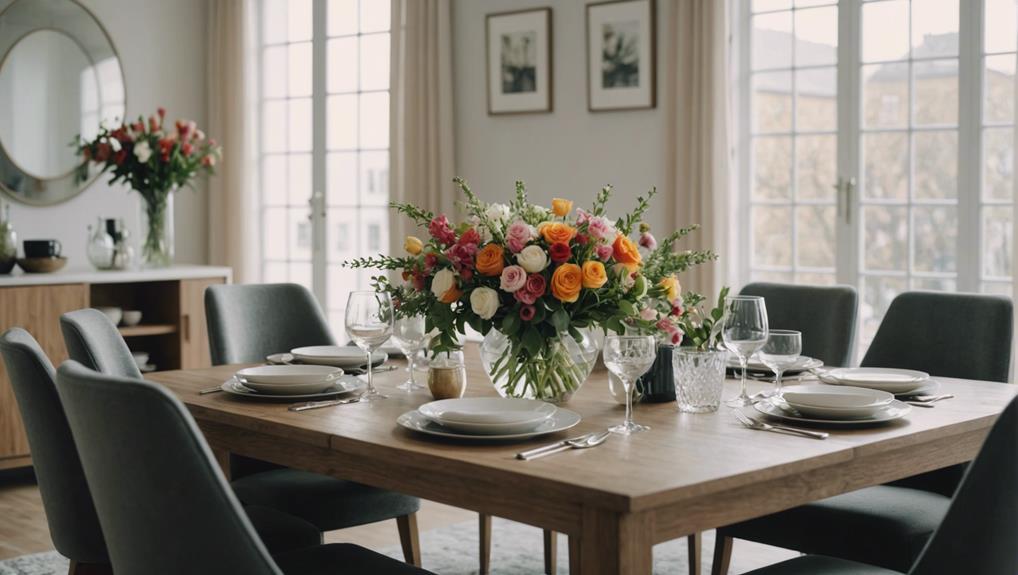Selecting tables for your living space involves considering size, shape, and material to enhance aesthetics and functionality. Rectangular tables offer versatility, while circular tables create cozy settings. Different types such as dining and coffee tables cater to various needs.
Styles range from traditional to industrial, each with unique features. Sustainable materials like reclaimed wood and concrete are gaining popularity. Attention to dimensions, style, and materials is crucial for making informed choices.
Proper care and maintenance tips ensure longevity. Understanding the art of table selection is essential for creating a harmonious living space that suits your style and needs.
Table of Contents
ToggleI. Definition of a Table
Tables are furniture pieces with flat surfaces supported by legs, used for dining, working, or displaying items. They come in shapes like rectangular, circular, square, and oval, each serving different needs and room layouts.
Rectangular tables are classic and versatile, ideal for accommodating multiple guests or for working.
Circular tables promote conversation and create a cozy atmosphere, perfect for small gatherings.
Square tables are great space savers and fit well in tight corners.
Oval tables blend features of rectangular and circular tables, offering a balance between form and function. Understanding the various table shapes helps in selecting furniture that enhances the practicality and style of living spaces.
A. Basic description
Tables are essential furniture pieces in living spaces, serving both aesthetic and practical purposes. They come in various types, such as dining tables and coffee tables, which contribute to the overall ambiance of a room.
Tableware like dishes, glasses, and cutlery are commonly used with tables, especially in dining rooms where they serve as gathering spots for sharing meals.
Factors like size, shape, and material play a key role in selecting the right table for a space, ensuring it complements other furniture and decor elements in the room.
Understanding the basic description of tables and their role in living spaces is crucial for making informed choices when enhancing your home environment.
B. Different types of tables
Different types of tables play specific roles in enhancing the functionality and aesthetics of living spaces. Coffee tables are placed in front of sofas for convenience, while dining tables are used for meals and gatherings.
Console tables are versatile and can be placed in entryways, hallways, or behind sofas for added style and functionality. Bedside tables in the bedroom are handy for essentials like lamps and books, while end tables complement sofas in the living room by holding items like drinks or a tablecloth.
Each type of table serves a distinct purpose, contributing to the overall appeal and practicality of different areas in the home. From enjoying a morning cup of coffee to sharing meals with family or simply having a spot to set down belongings, the right table choice can significantly enhance the living space.
II. History of Tables
Tables have been a significant part of human society since ancient times, with the earliest known table dating back to around 2500 BC in ancient Egypt. The Greeks and Romans used tables for dining and social gatherings, reflecting the social status of the owners through design and material.
During medieval times, trestle-style tables were popular for easy assembly and disassembly in homes and banquet halls. The Renaissance period saw elaborate tables with intricate carvings, showcasing craftsmanship and affluence.
Over time, tables evolved to meet changing needs, resulting in a diverse range of styles and functions seen today. From utilitarian to ornate, tables reflect cultural norms, technological advancements, and individual preferences.
A. Early uses and designs
During the late Victorian era, early coffee tables emerged with the primary function of holding tea trays, crafted mainly from wood to showcase traditional craftsmanship and add elegance to home decor.
As living rooms gained prominence in the 20th century, the popularity of coffee tables soared, solidifying their place as essential living room furniture.
These early coffee tables featured intricate carvings, elaborate designs with detailed carvings for a sophisticated look, simple shapes focused on practicality and ease of use, and traditional craftsmanship highlighting woodworking techniques and attention to detail.
B. Evolution over time
Table selection has evolved towards multifunctional designs to maximize space efficiency and incorporate innovative storage solutions for added practicality. This trend combines style and functionality to cater to diverse contemporary living space needs. Tables now offer customizable options to suit personal preferences and room aesthetics.
Sustainability is emphasized with eco-friendly materials and designs becoming more prominent. Tables have transformed into versatile elements that contribute to overall space design and functionality. By incorporating storage solutions and customizable features, modern tables are essential in creating efficient and aesthetically pleasing living environments that adapt to evolving individual and household needs.
III. Materials Used in Table Construction
Table construction materials play a crucial role in determining the aesthetic appeal and functionality of furniture pieces. Common materials used include Wood, Glass, Metal, and Marble.
Wood offers durability and a natural aesthetic appeal, suitable for dining tables and coffee tables.
Glass provides a modern, sleek look and is easy to clean, commonly used for side tables and console tables.
Metal offers a contemporary industrial style and strong support, ideal for outdoor tables and desks.
Marble presents a luxurious appearance with unique veining patterns, often used for accent tables and countertops.
Each material brings unique benefits to table construction in terms of style, durability, and functionality.
A. Wood
Wood tables, such as those made from oak, maple, cherry, and walnut, are preferred for their durability, classic appeal, and diverse design options.
Solid wood tables are robust and long-lasting, suitable for daily use. These tables can be finished in various ways, including staining, painting, or leaving natural, to enhance their appearance and protect the surface.
Proper care involves regular dusting, avoiding moisture exposure, and using coasters to prevent damage from heat or spills. Wood tables aren't only aesthetically pleasing but also enduring, making them a valuable investment for your home.
Types of wood
In furniture selection, the choice of wood for tables significantly impacts aesthetics and durability. Hardwoods like oak, maple, and walnut are durable and long-lasting, ideal for heavy-use tables.
Softwoods such as pine and cedar offer budget-friendly options with a rustic look. Exotic woods like teak, mahogany, and cherry provide unique colors and grain patterns for a luxurious touch.
Reclaimed wood tables, made from salvaged wood, offer eco-friendly and sustainable options. Each wood species varies in hardness, grain patterns, and finishes, providing diverse design possibilities to suit personal preferences.
Benefits and drawbacks
Square coffee tables offer versatility and complement various interior decor styles. They provide additional storage options like drawers or shelves, making them practical for households with kids as they're less likely to be knocked over.
Square tables fit well in small or large living rooms, complement various furniture arrangements, and can be a practical choice. However, they may provide limited space utilization in smaller rooms compared to other shapes.
B. Metal
Metal coffee tables are durable and resistant to wear and tear, making them suitable for high-traffic areas. They come in various finishes like chrome, brass, and bronze, seamlessly integrating into different decor styles.
Some metal coffee tables feature intricate designs or patterns, adding a decorative element to the room. Their easy-to-clean properties make them practical for busy households.
Metal coffee tables provide versatility to cater to various tastes, whether minimalist or ornate. With their ability to withstand daily use and stylish appearance, metal tables are a great addition to modern living spaces.
Types of metal
Metals commonly used in crafting coffee tables include stainless steel, iron, brass, copper, and aluminum. Stainless steel is known for durability and a modern aesthetic, while iron provides a rugged look suitable for industrial-style tables.
Brass and copper accents add elegance and warmth, creating a cozy atmosphere. Aluminum, lightweight and sleek, is favored in minimalist designs for a clean, modern look. Metal tables offer finishes like matte, brushed, or polished, catering to diverse aesthetic preferences.
Benefits and drawbacks
Square coffee tables provide practical advantages in living spaces. They offer versatility, complementing any interior decor style effortlessly. With balanced proportions, they're suitable for both small and large rooms, providing functionality without overwhelming the space. Square tables offer extra storage options like drawers or shelves, aiding in maintaining an organized and clutter-free living area.
In households with children or pets, square coffee tables are a safer choice as they're less likely to be knocked over. Their sturdy design ensures stability, especially in busy family environments. These tables not only add a touch of style but also bring practicality and convenience. While square tables may occupy more floor space compared to round or oval options, their benefits in enhancing living spaces outweigh this drawback.
C. Glass
Glass coffee tables enhance the modern and elegant look of any living space. Here are some key points to consider when choosing a glass table for your home:
- Transparent nature of glass tables creates a sense of spaciousness in a room.
- Easy maintenance and cleaning make glass tables ideal for busy households.
- Reflective surface of glass tables helps in spreading light and brightening the room.
- Combining glass with materials like metal or wood adds depth and visual interest to the decor.
- Versatile glass tables seamlessly blend with various interior design styles, from minimalist to eclectic.
Integrating a glass coffee table not only enhances the aesthetic but also adds sophistication and refinement to the living space.
Benefits and drawbacks
Square coffee tables are a versatile choice for any interior decor style, offering extra storage options like drawers or shelves to help manage clutter. Their stability makes them ideal for households with kids or pets, and they fit well in both small and large living rooms.
Square coffee tables seamlessly blend style and functionality, enhancing the overall aesthetic of the room. While they may not be as space-efficient in smaller rooms compared to round or rectangular options, their benefits often outweigh any drawbacks, making them a smart choice for many living spaces.
D. Plastic
Plastic tables are favored by homeowners for their convenience, durability, customization options, affordability, and easy maintenance. They're lightweight and easy to move, resistant to moisture, customizable in various colors and styles, budget-friendly, and simple to clean with just a wipe down using a damp cloth.
These qualities make plastic tables a practical and cost-effective choice for enhancing living spaces.
Benefits and drawbacks
Square coffee tables offer versatile styling options suitable for any interior decor style. They provide extra storage solutions like drawers or shelves for added functionality. Square tables are less likely to be knocked over, making them ideal for households with kids or pets, ensuring safety and durability.
Whether in small or large living rooms, square coffee tables fit well and enhance the space by providing a focal point. Their combination of style and practicality makes them a great addition to any room, adding both aesthetic appeal and usability. However, it's important to consider the potential for sharp corners in households with small children and to select the appropriate table size to ensure it complements the room without overwhelming it.
IV. Different Styles of Tables
Various styles of tables offer unique design features to cater to different aesthetic preferences and functional needs.
Traditional tables are known for their ornate detailing and timeless appeal, adding sophistication to any room.
Modern tables feature sleek lines and minimalist aesthetics, exuding a contemporary vibe.
Rustic tables embrace natural materials like reclaimed wood, creating a cozy, farmhouse-inspired atmosphere.
Industrial tables incorporate metal elements and distressed finishes, bringing a raw, urban edge to spaces.
Eclectic tables blend various design elements, materials, and colors to create a vibrant and one-of-a-kind look, making a bold statement in any room.
A. Traditional
Traditional tables are known for their classic elegance and timeless charm, showcasing sophistication through intricate designs and rich materials like wood. Crafted with a focus on detailed craftsmanship and ornate features, these tables add a touch of luxury to any living space.
When selecting a traditional table, consider various styles such as antique pieces with intricate carvings, reproduction furniture capturing vintage charm, and vintage-inspired designs that blend classic elements with modern functionality. Wood is a prevalent material in traditional table construction, offering rich finishes that enhance the overall look and feel of the piece.
To illustrate the variety within traditional tables, here is a comparison table showcasing different styles:
- Antique: Features intricate carvings and ornate details.
- Reproduction: Captures vintage charm with a timeless appeal.
- Vintage-inspired: Combines classic elements with modern functionality.
B. Modern
Modern tables in interior design trends feature clean lines, sleek finishes, and minimalist aesthetics for a contemporary look. When selecting modern tables for your living space, consider the following key points:
- Glass, metal, and polished wood are commonly used materials in modern table designs.
- Tables may incorporate geometric shapes, asymmetrical designs, or mixed materials for a stylish appeal.
- Functionality is prioritized with features like hidden storage compartments, adjustable heights, or built-in technology integration.
- The color palette for modern tables leans towards neutrals, monochromatic schemes, or bold accents to enhance the modern feel.
- Embrace the sleek and stylish nature of modern tables with designs that exude simplicity and a contemporary vibe.
C. Rustic
Rustic tables emphasize natural elements like wood, stone, and earthy tones, creating a cozy atmosphere in your living space.
Distressed finishes, reclaimed wood, and vintage accents are common in rustic table designs, adding authenticity to your home decor.
Crafted with hand-carved motifs or rough-hewn textures, these tables showcase intricate craftsmanship.
Farmhouse tables, known for their sturdy construction, are a popular choice in rustic decor, offering functionality and charm.
D. Industrial
Industrial style tables feature a combination of distressed wood and steel, incorporating elements like wheels, gears, and pipes for a rugged and mechanical aesthetic.
The color palette typically includes shades of gray, black, brown, and metallic tones, inspired by factories and warehouses, adding an urban design touch to your space.
These tables make a bold statement in any room, providing a functional surface for everyday use.
V. Choosing the Right Table for Your Space
When choosing a table for your living space, consider factors such as size, shape, material, additional features, and decor cohesion.
The size of the table should fit the space for easy movement. Choose a shape that matches the room layout, such as rectangular, circular, or square.
Evaluate materials like wood, glass, or metal based on lifestyle and budget. Look for features like storage options to enhance functionality.
Ensure the table complements the room's decor for style and practicality. By considering these factors, you can select a table that fits your space and enhances the overall look of your living area.
A. Size considerations
When choosing a table for your living space, consider the dimensions of the area to ensure a comfortable fit without overcrowding. Measure the available space to avoid a table that's too small or large.
Assess the scale of surrounding furniture for visual balance. Select a table size that allows for easy movement around it, enhancing convenience.
Evaluate the table's height in relation to seating arrangements for comfort and aesthetic appeal.
B. Style considerations
Considering the color scheme, texture, and materials of a table is crucial to ensure it complements the room's decor. Explore various styles like modern, traditional, rustic, or eclectic to find the perfect match for your living space.
Pay attention to design details such as leg shape, tabletop finish, and overall aesthetic to enhance the room's ambiance. Experiment with different shapes like rectangular, round, or oval tables to see which style best suits your living area.
Look for tables that offer a blend of functionality and style, including storage options, unique designs, or customizable features. Selecting a table that aligns with the room's style and incorporates practical elements can help create a cohesive and visually appealing living space that meets both aesthetic and functional needs.
C. Material considerations
Selecting the right material for your table is crucial to enhance the overall look and functionality of your living space. When choosing a material for your table, consider the following:
- Wood: Known for warmth, durability, and versatile design options, wood is a popular choice for coffee tables.
- Glass: Offering a modern and sleek aesthetic, glass coffee tables create an illusion of space, ideal for smaller rooms.
- Metal: Durable and industrial-chic, metal coffee tables suit modern or contemporary interiors.
- Marble: Adding luxury and sophistication, marble coffee tables elevate any living space, though they may need more maintenance.
- Lifestyle Factors: Consider your lifestyle, including children or pets, when selecting a material to ensure longevity and practicality.
The material you choose significantly impacts the style and functionality of your living space.
VI. Proper Table Care and Maintenance
Regularly cleaning the table surface with a mild cleaner helps remove dust and debris. Using coasters is vital to protect the table from water rings and heat damage.
Avoid placing heavy or sharp objects directly on the table to prevent scratches and dents. Checking and tightening any loose screws or fittings is necessary to maintain stability.
Following the manufacturer's care instructions based on the table material is key to ensuring proper care. These steps help prolong the life of your table and maintain its functionality and aesthetic appeal.
A. Cleaning tips
To maintain the cleanliness and longevity of your table, start by using a microfiber cloth or soft brush for regular dusting. Keeping your table clean not only enhances its appearance but also protects it. Here are essential cleaning tips to preserve your table:
- Use a microfiber cloth or soft brush for regular dusting.
- Wipe down the table with a damp cloth or mild soap solution for routine cleaning.
- For tough stains, consider using a vinegar and water mixture or a specialized cleaner recommended for the table material.
- Avoid abrasive cleaners or harsh chemicals that can harm the table's finish.
- Consider applying a protective coating or wax to maintain the table's shine and safeguard it from scratches.
B. Repair and restoration
Furniture repair and restoration can prolong the lifespan and enhance the appeal of worn-out tables. Techniques like sanding, refinishing, and upholstery repair can revitalize old or damaged tables.
Professional restoration services are crucial for safeguarding the authenticity of antique tables. DIY projects for table repair can be cost-effective with the right tools.
Prompt repairs are essential to prevent further damage and enjoy the beauty of tables for years to come.
VII. The Role of Tables in Interior Design
Tables in interior design serve as focal points in rooms, defining layout and flow. They come in various types like coffee tables, dining tables, and console tables, catering to specific needs.
Choosing the right tables elevates the room's look and feel, impacting the atmosphere significantly. Understanding the role of tables is crucial for creating visually appealing living spaces.
A. How tables can enhance a room
Tables are essential elements in interior design, serving as focal points that anchor a room's aesthetic and contribute to its organization. The right table choice offers storage solutions or functions as a display area for decor, adding practicality and style.
Tables greatly enhance a room's visual appeal, contributing to its overall aesthetic. By selecting tables that complement the space, the room's flow can be improved, creating a harmonious atmosphere. Additionally, tables help define different areas within a room, optimizing space effectively.
Choosing the right tables enhances the room's visual appeal and creates a cohesive living environment.
B. The impact of table shape and size on room dynamics
The shape and size of a table are crucial factors in defining the atmosphere and functionality of a room. Square tables offer a balanced and structured look, maximizing surface area without occupying excessive space, making them ideal for smaller rooms.
The functionality and comfort of a room are influenced by the size of the table, with square tables providing ample space for various activities. These tables can promote intimacy during gatherings or conversations, enhancing symmetry and coordination with other furniture pieces to contribute to the overall harmony of the space.
VIII. Environmental Impact of Table Production
Table production has a significant environmental impact due to resource extraction, manufacturing processes, and transportation. Wood tables, if not sustainably sourced, contribute to deforestation, negatively impacting ecosystems and biodiversity. Metal tables require energy-intensive mining and processing, leading to carbon emissions and habitat destruction. Plastic tables, often made from non-biodegradable materials, add to plastic pollution and harm marine life.
To minimize the environmental footprint of table production, opting for eco-friendly materials such as reclaimed wood, recycled metal, or bamboo is essential. These alternatives help reduce the strain on natural resources and mitigate the negative consequences associated with traditional table production methods. Choosing tables made from sustainable materials enhances your living space while also positively impacting the environment. Making informed decisions about the tables you bring into your home promotes a more eco-conscious lifestyle.
A. Sustainability in material sourcing
Sustainable material sourcing is crucial in reducing the environmental impact of table production. Key points to consider include using eco-friendly materials like reclaimed wood, bamboo, or recycled metal for table construction.
Ethical sourcing practices ensure responsible material acquisition, minimizing environmental harm and supporting fair trade. Certifications like FSC (Forest Stewardship Council) verify sustainable wood sourcing for eco-conscious furniture choices.
Sustainable sourcing promotes conservation efforts, reduces carbon footprint, and supports renewable resources in furniture manufacturing. Opting for tables made from sustainable materials contributes to a greener living space and aligns with environmentally-friendly lifestyle choices.
B. Impact of production processes
Production processes impact the quality, durability, and aesthetics of tables. The methods used, whether handcrafted or mass-produced, determine the uniqueness and value of a table.
Sustainable production processes are gaining importance, offering eco-friendly furniture options. Custom production techniques provide flexibility for personalized design choices, ensuring tables meet specific needs and preferences.
IX. Future Trends in Table Design
Future trends in table design are evolving with the integration of technology, sustainable materials, modular and customizable designs, multifunctionality, and innovative shapes and structures. These developments include built-in charging stations, touch controls, and smart capabilities for added convenience. Sustainable materials like reclaimed wood, bamboo, and recycled metal are being used to promote environmental consciousness.
Tables are being designed with modular and customizable features to adapt to changing needs easily. They're also integrating multifunctionality, serving as desks, storage units, or entertainment centers. Furthermore, experimentation with unconventional forms, asymmetrical designs, and floating table concepts is pushing the boundaries of traditional aesthetics.
A. Technological advancements
The selection experience for modern consumers seeking to elevate their living spaces is enhanced through the latest technological advancements. Users can visualize furniture in their space before purchase using virtual reality tools, creating a more immersive shopping experience. Augmented reality apps allow real-time superimposition of different table options, aiding decision-making.
Online platforms offer 3D room planning tools for users to see how various tables will fit and look in their rooms. AI algorithms recommend tables based on individual style preferences and room dimensions, streamlining the selection process. Smart furniture devices incorporate technology like wireless charging capabilities or built-in speakers, adding functionality to tables.
B. Emerging styles and materials
The world of table selection for enhancing living spaces involves various styles and materials that shape modern furniture. Key trends include industrial, Scandinavian, and mid-century modern designs, reclaimed wood, concrete, and mixed metals for unique textures and durability.
Innovative materials like acrylic, resin, and concrete are utilized to create unique table designs. Sustainable options such as bamboo, recycled plastic, and reclaimed wood are eco-friendly choices.
Hybrid materials like wood and metal combinations offer a blend of rustic charm and contemporary appeal.
X. Conclusion
Selecting the right table for your living space involves considerations such as size, style, and functionality. The choice of table significantly impacts how you utilize and interact with your room.
Factors like material, shape, and design play a crucial role in creating a cohesive and practical environment that reflects your style. A well-chosen table can serve as a focal point, enhancing the room's versatility and appeal.
A. Recap of key points
Key considerations when choosing tables for your living space include:
- Selecting a coffee table to create a focal point
- The benefits of square coffee tables for versatility and space-saving
- Factors like size, shape, materials, styles, and practical applications when shopping for a dining table
- Aspects like table stability, aesthetics, leg designs, color customization, room size considerations, and maintenance
Elevate your space by considering:
- Practicality
- Theme selection
- Tray options
- Layering techniques
- Balance and symmetry principles
- Incorporating greenery.
B. Final thoughts on the importance of tables
Tables are essential furniture pieces that provide surfaces for various activities and contribute to the design of a room. The right choice of tables can transform a space, creating a harmonious atmosphere.
Quality tables ensure durability and long-term satisfaction with the living environment. Whether it's a dining table, work table, or decorative accent table, each serves a specific purpose and adds character to the space.
Careful consideration of table options is vital in achieving a cohesive and aesthetically pleasing living area that reflects personal style and functionality requirements.





